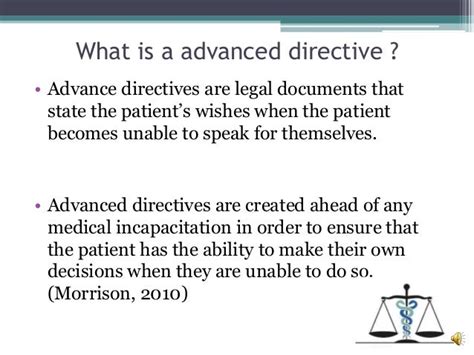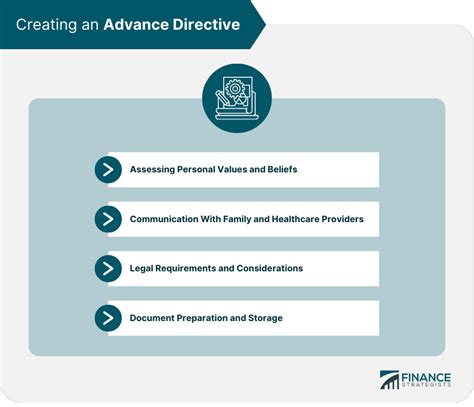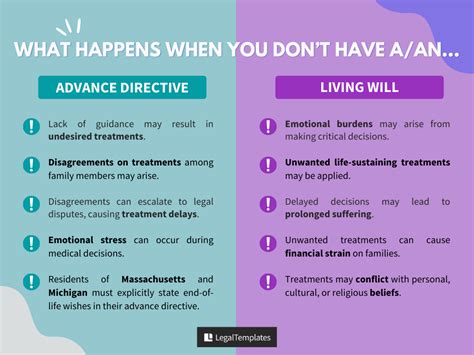Intro
Discover how Advance Directives work, ensuring end-of-life care, medical decisions, and living wills are respected, with 5 key methods for advance care planning, healthcare proxy, and durable power of attorney, securing patient autonomy and informed consent.
The importance of planning for the future, especially when it comes to healthcare, cannot be overstated. As individuals, we often find ourselves faced with difficult decisions, and in the event that we become unable to make those decisions for ourselves, having a plan in place can provide peace of mind for both ourselves and our loved ones. One crucial aspect of this planning is the advance directive, a document that outlines our wishes for medical treatment in the event that we become incapacitated. Understanding how advance directives work and their significance in ensuring that our healthcare preferences are respected is vital for everyone.
Advance directives are not just about end-of-life care; they are about ensuring that our autonomy and dignity are preserved throughout our lives. By specifying the types of medical treatments we do or do not want to receive, we can rest assured that our values and beliefs are respected, even when we cannot communicate them ourselves. This not only allevates the burden on family members and healthcare providers but also ensures that any decisions made on our behalf align with our own desires. The process of creating an advance directive involves careful consideration and open communication with loved ones, leading to a deeper understanding of each other's wishes and values.
The concept of advance directives may seem straightforward, but its implications and applications are multifaceted. It involves understanding the legal, ethical, and personal aspects of healthcare decision-making. By delving into the specifics of how advance directives work, including the different types, their legal standing, and the process of creating one, individuals can better navigate the complex landscape of healthcare planning. Moreover, exploring real-life scenarios and the benefits of having an advance directive can further illustrate its importance and encourage more people to engage in this critical aspect of planning for the future.
Introduction to Advance Directives

Types of Advance Directives
Understanding the different types of advance directives is crucial for creating a comprehensive plan that reflects one's wishes. A living will, for example, is a document that outlines the types of medical treatments one does or does not want to receive if they become terminally ill or are in a permanent vegetative state. On the other hand, a durable power of attorney for healthcare appoints a person to make healthcare decisions on one's behalf, should they become incapacitated. Do-not-resuscitate (DNR) orders are specific instructions to not perform CPR if one's heart stops or if they stop breathing.The Process of Creating an Advance Directive

Benefits of Advance Directives
The benefits of having an advance directive are numerous. It ensures that one's autonomy is respected, even when they cannot communicate their wishes. This not only provides peace of mind for the individual but also alleviates the burden on family members and healthcare providers, who might otherwise face difficult decisions without clear guidance. Advance directives can also help prevent conflicts among loved ones by providing a clear understanding of one's wishes. Furthermore, they encourage open communication about end-of-life care and values, promoting a deeper understanding and respect among family members.Legal Standing of Advance Directives

Challenges and Controversies
Despite their importance, advance directives can sometimes be challenging to implement, especially in emergency situations where there may not be time to locate the document or verify the patient's wishes. Additionally, conflicts can arise if family members or healthcare providers disagree with the directives outlined in the document. These challenges highlight the need for clear communication and for ensuring that all relevant parties are aware of one's advance directive and its contents.Real-Life Scenarios and the Importance of Advance Directives

Encouraging Open Communication
Advance directives encourage open communication about end-of-life care and values, which is beneficial for individuals and their families. By discussing one's wishes and preferences, individuals can ensure that their loved ones understand and respect their decisions. This open communication can also lead to a deeper understanding and respect among family members, reducing the potential for conflict in the future.Conclusion and Next Steps

Final Thoughts
The creation and implementation of advance directives are complex issues that touch on legal, ethical, and personal aspects of healthcare. By delving deeper into these topics and exploring the nuances of advance directives, we can work towards a future where everyone's wishes are respected and valued. This not only requires individual action but also a broader societal commitment to prioritizing open communication, respect, and dignity in healthcare decision-making.What is the purpose of an advance directive?
+An advance directive is a legal document that allows individuals to specify their healthcare preferences in advance, should they become unable to communicate their decisions. It ensures that one's autonomy and dignity are preserved, even when they cannot communicate their wishes.
What types of advance directives are there?
+There are several types of advance directives, including living wills, durable powers of attorney for healthcare, and do-not-resuscitate (DNR) orders. Each serves a unique purpose, from outlining specific medical treatments to appointing a healthcare proxy.
How do I create an advance directive?
+Creating an advance directive involves understanding the laws in your state, choosing a healthcare proxy, discussing your preferences with them and other family members, and then writing and signing the document according to your state's requirements.
We invite you to share your thoughts and experiences with advance directives. Have you or a loved one created an advance directive? What challenges or benefits have you encountered? Your insights can help others navigate this critical aspect of healthcare planning. Please comment below or share this article with someone who might find it helpful. Together, we can promote a better understanding and respect for advance directives, ensuring that everyone's wishes are valued and respected.
